Habitat. It grows in swamps, ditches and ponds, in standing and slow-moving waters throughout the country. Blooms from July to September.
Chemical composition and medicinal properties. —
Definition and similar plants. Plant of the bladderwort family. The genus Pemphigus, the largest in the family, includes about 200 species, living mainly in the tropics (South America, Central Africa, Southeast Asia, Australia). In addition to common bladderwort, bladderwort (Utricularia intermedia Hayne) and bladderwort (Utricularia minor L.) also grow in central Russia. These species are less common and have smaller flowers.
H.van BROGGEN Holland
Plants of the genus Ulricularia are among those rare representatives of the plant kingdom that do not limit their nutrition to components of mineral or organic origin contained in the soil, water and air.
These plants are carnivorous. Those of them. which have developed lakes, ponds and swamps, eat mainly small inhabitants of water spaces. For terrestrial plants, the basis of food consists of various crawling and flying invertebrates, as well as insects living in the ground.
A unique Organ, the trapping vesicle, helps these plants capture and utilize prey, for which they are popularly called “pemphigus.” Pemphigus is cosmopolitan and can be found on all continents. THERE ARE them in Europe, although they are represented here rather sparingly - only 6-8 species, of which the most typical is bladderwort (Utricularia vulgaris L.).
This interesting plant prefers silted, humus-rich reservoirs, which become a refuge for a large number of aquatic organisms in the spring and autumn. In its natural habitat, bladderwrack forms dense thickets not connected to the ground, concentrated mainly in the coastal zone. In this situation, for an inquisitive nature lover, it is not difficult to get yourself a sprig of bladderwort and place it in an aquarium for further observation, but if for some reason you are unable to look for bladderwort in a natural body of water, contact the staff of the nearest botanical garden for help: for sure There is an extra specimen in the collection of aquatic plants. Bladderweed is a summer green plant. With the onset of the first warm spring days, it rapidly begins to grow and quickly forms dense thickets made up of branched stems almost a meter long. densely covered with alternate dissected leaves and armed with many oval or round vesicle traps approximately 4 mm long.
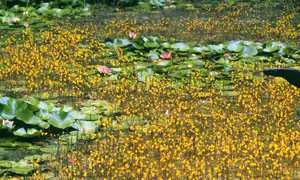
Photo of blooming bladderwort
The peduncle is usually 15-40 cm long and carries 4 to 15 bright yellow flowers with a red-brown sky above the water. The upper lip is rounded, 7-10 mm long. The lower lip is pubescent, has a length of 13-lfi mm and is decorated with a 6-8 mm cone-shaped spur. The fruit is spherical, about 6 mm in diameter. contains numerous small (up to half a millimeter long) seeds.
Utricularia vulgaris is found mainly in the temperate zone of the northern hemisphere, and is partially present in the Mediterranean region of Europe. In Africa, with the exception of Shaba (Zaire), pemphigus was collected almost everywhere along an almost straight line from Sudan to South Africa. This narrowly elongated shape of the habitat indirectly confirms the theory that the main dispersal factor for this plant is migratory birds.
I cannot describe in detail the prevalence and localization of the habitats of bladderwort in Russia and the republics of the former Soviet Union. I will only mention that in the specialized literature on the freshwater flora of Central Europe there are indications that this species is distributed at least “up to the eastern borders of the Baltic republics of the USSR.”
Utricularia vulgaris grows in sheltered from the wind, exposed to sunlight or semi-shaded places in shallow or moderately deep, mostly stagnant, humus-rich, and at the same time unpolluted reservoirs, also composed of clay or loose silt.
In the aquarium, plants form very decorative long light green garlands freely floating on the surface of the water. Bladderwort has no roots, so there is no point in planting it in the ground. It is also inadvisable to press the plant to the ground with a pebble or hairpin. The recessed end soon rots, and the plant still rises to the surface of the water. Utricularia vulgaris, in general. cannot be called a capricious plant. The only thing she absolutely needs is an abundance of light. With regard to other environmental parameters, the bladderwort does not show excessive demands, except that it does not like an abundance of mechanical suspension, so filtration in an aquarium with utricularia should be quite effective.
“But how can we feed this carnivorous plant?” - you ask. Don't be alarmed, this factor is yes-
not very decisive. If you give crustacean fish other live food, then the plant will get something, but if not, it won’t. The thing is. that the chloroplasts of bladderwort, like those of typical plants, contain chlorophyll. Thus, the assimilation capabilities of the plant are not limited to feeds of exclusively animal origin. Moreover, if you have the opportunity to observe a plant caught in the wild and placed in an aquarium for a long time, you may notice that its bubble bubbles will begin to gradually reduce and eventually the bladderwort will lose the ability to catch even any kind of fish with its traps. some sedentary daphnia. True, scientists have not yet been able to come to a consensus on whether such a me-
Tamorphosis is an independent factor or it manifests itself solely as a consequence of insufficient animal nutrition.
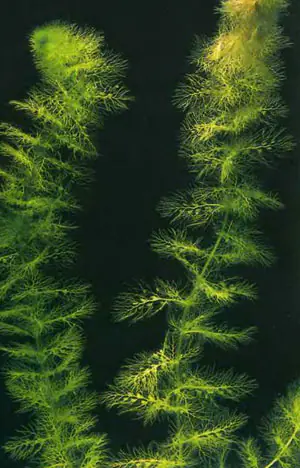
Photo of pemphigus vulgaris
Keep in mind that plants with well-developed trapping vesicles pose a very real danger not only to aquatic invertebrates, but also to fry. On the other hand, I cannot help but mention that in some of my aquariums, freshwater shrimp Caridina serrala coexist with bladderwort. and I did not observe any conflicts between these inhabitants of indoor ponds.
As for mineral feeding, pemphigus reacts positively to it, especially when it comes to carbon dioxide. At the same time, it is quite possible to do without it. In particular, I went back to the technology of CO supply. in the aquarium was still very far from perfect and the method of taking care of aquatic plants in everyday life was practically not used; in one of my aquariums simply magnificent thickets of urticula-ria were formed. The plant even bloomed periodically, however. the flowers were pale yellow, which is typical for the population growing in the shade.
Pemphigus reproduces in the most primitive way - by separating numerous branches from the main stem. Often the old stem simply dies off, and then the lateral layers are freed without any intervention from the aquarist.
Sexual reproduction is also possible - with the help of seeds, which have a very decent germination rate if they are first kept in the freezer of the refrigerator for several days. Young shoots are quite viable, but in order to achieve their sustainable growth, I recommend that at first (at least for a couple of weeks) place them in water with a large number of ciliates.
In a warm-water aquarium, plants grow throughout the year. In nature, with the onset of cold weather, the green parts of the bladderwort die off, and numerous overwintering buds remain in the water, which wait for better times by sinking closer to the ground.
The attractiveness of bladderwrack can be appreciated not only by aquarists, but also by owners of decorative backyard ponds. True, they should keep in mind that neighbors in the pond need to be selected for it with caution: competition with powerful, violently vegetative and quickly
By filling the entire space with hydrophytes, bladderwort usually loses. It prefers a spacious pond with slowly growing, rooted plants. However, if you are the proud owner of a pond, try throwing in a couple of sprigs of Ilricularia: the flowering bladderwort is a magnificent sight.

Photo of pemphigus vulgaris peduncle
The structure of the flowers of bladderwort resembles the snapdragon, which is familiar to many. Pollination occurs due to large flying insects, such as bumblebees. Pollen capsules are usually located below the stigma and pressed against the pistil. Thus, pollen cannot reach the stigma on its own. As soon as the bumblebee lands on the lower lip, it bends under its weight and allows the insect to penetrate deep into the flower to get to the nectar.
At the same time, it inevitably touches the capsule and becomes covered with pollen. At this time, the pestle bends, its stigma rests on the upper lip. Then the stigma unfurls and inevitably touches the pollen capsule.
Fruit formation in bladderwort is very intensive. The fruit is a spherical capsule-box densely packed with seeds.
As the seeds ripen, the walls of the capsule lose elasticity, and under the influence of wind or animals it opens. The capsule floats on the surface of the water for some time, then its shell rots and the seeds are released. Some of the seeds remain in the native pond, while others are pecked by birds, and then, along with their feces, are spread throughout the reservoirs.
Speaking about pemphigus, we cannot ignore its trapping bladders. The mouth opening of the “trap” of pemphigus vulgaris is funnel-shaped and is equipped with a special valve that prevents the trapped object from getting out. The edges of the funnel are covered with thick fluff. At rest, the walls of the bubble are pressed inward due to the reduced pressure in its cavity. As soon as the insect approaches the mouth opening and disturbs the sensitive hairs, the valve sharply opens, the walls of the bubble bend and a stream of water rushes into it, dragging the potential victim along with it. Then the valve closes, and the prey begins to be gradually digested due to a special secretion secreted by the walls of the trapping bladder. Having disposed of the insect, the bubble pushes out the water and is ready to hunt again. True, each time certain indigestible fragments of prey remain in this cavity. Having filled with this waste, the bubble dies (when you pull out a bunch of pemphigus from a natural reservoir, you can hear a slight rustling: these are bubbles filled with residues that have become unnecessary).

Photo box with seeds
Of course, the victim does not always completely fit into the cavity of the trapping bubble. But, as it turned out, relatively large prey has little chance of salvation - even if, say, only the tail OR the head is caught in the trap. It turned out. that the bladderwort copes quite quickly with “disproportionate” food, drawing it into the bubble Gradually, as the previous portion is digested.
In conclusion, I would like to remind readers that bladderwort is far from the only plant of the genus Llricularia (it has about 200 species, most of which, however, are terrestrial) suitable for keeping in an aquarium.
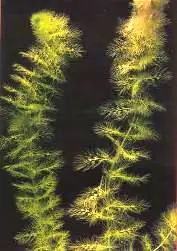
Common bladderwort (Utricularia vulgaris L.)
To the rarest representatives of carnivorous plants, i.e. plants that do not limit their nutrition to the mineral components contained in the soil, water and air include representatives of the genus Pemphigus = Utricularia. They have colonized lakes, ponds and swamps, where they consume mainly small living aquatic inhabitants as food. For carnivorous terrestrial plants, the diet is based on various crawling and flying insects and other invertebrates.
These plants have a unique organ - a trapping vesicle, which helps these plants capture and utilize prey. Because of these trapping organs, this plant received the name “pemphigus”. Pemphiguses are cosmopolitan, as they can be found on almost all continents. In Europe, pemphigus is represented by only 6-8 species, of which the most typical and widespread is pemphigus vulgaris.
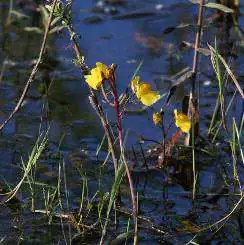
Common bladderwort prefers to colonize silted, humus-rich water bodies, which are home to a large variety of small aquatic organisms in the spring and autumn. Here, bladderwort forms dense thickets that are not connected to the ground, concentrating mainly in the coastal zone closer to shallow water. Common bladderwort belongs to the group of summer-green plants that rapidly begin to grow with the onset of the first warm spring days. Bladderwort quickly forms dense thickets, which consist of branched stems, often reaching almost a meter in length. Its stems are densely covered with alternately dissected leaves, which are armed with many bubble-traps of oval or round shape. They reach a length of approximately 4 mm.
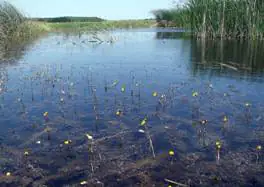
Pemphigus vulgare is a flowering plant. Its flower stalk, usually about 15-40 cm long, rises above the surface of the water, displaying 4 to 15 bright yellow flowers with a red-brown palate. The upper lip of the flowers is rounded, 7-10 mm long, and the lower lip is 13-16 mm long and pubescent below, it is decorated with a 6-8 mm cone-shaped spur. The fruit of the common bladderwort is spherical, contains numerous small seeds, each up to half a millimeter long, and the fruit itself usually does not exceed 6 mm in diameter.
Pemphigus vulgaris is mainly found in the temperate zone of the northern hemisphere. It can be found in the Mediterranean region of Europe, and in Africa, pemphigus lives almost everywhere along a relatively narrow line from Sudan to South Africa, with the exception of the Shaba region in Zaire. This narrowly elongated shape of the range indirectly confirms the hypothesis that the main settlers and distributors of this plant across the African continent are migratory birds migrating south for the winter. This species is also found in the west of the European part of the former USSR.
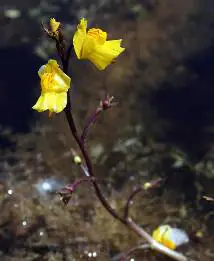
Pemphigus vulgaris grows mainly in shallow or moderately deep, mostly stagnant fresh water bodies. It prefers areas protected from the wind, well illuminated by the sun's rays, and is also found in semi-shaded places, but with water rich in humus, but not in polluted reservoirs.
Pemphigus vulgare in the aquarium
In the aquarium, bladderwort forms very decorative garlands of long light green stems freely floating on the surface of the water. And since bladderwort has no roots, there is no point in planting it in the ground. It is also inadvisable to press this plant to the ground with a pebble or a hairpin, since the submerged end soon rots and the plant rises to the surface of the water again.
When kept, bladderwort turns out to be not a capricious plant. The only condition is an abundance of light, and in relation to other parameters of the surrounding aquatic environment, the bladderwort does not show any special requirements. At the same time, she does not like an abundance of mechanical suspension, so filtration in the aquarium must be established. But you should not worry specifically about feeding this insectivorous plant, since this factor is far from decisive in the life of bladderwrack. But if you give the fish small crustaceans or other live food, then the plant will definitely get something. The chloroplasts of bladderwort, like those of typical plants, contain chlorophyll, therefore, the assimilation capabilities of the plant are not limited by animal feed.
Naturalists have noticed that plants caught in nature and placed in an aquarium begin to change over time: their trap bubbles begin to gradually decrease and eventually disappear completely, and the bladderwort loses the ability to catch even any sedentary prey with its natural traps. However, scientists have not come to a consensus whether such metamorphosis is a consequence of insufficient animal nutrition or is due to other factors.



